Let me tell you about the only comic book to ever make me cry in public.
From the first page of Amazing Spider-Man #121 something is off. There’s no title. Simply a sombre note from editorial telling the reader that they won’t actually learn what the name of the story is until the end. But it’s still very much a seventies Spider-Man story; bright primary colour palette, soap opera melodrama to burn and an exclamation point/period ratio of around 90 to 1. Norman Osbourne, who used to be the Green Goblin but has forgotten the whole thing because of amnesia, is undergoing a psychological breakdown because his son Harry went on a bad acid trip (did I mention that this came out in the seventies?). Suddenly, he relapses and remembers not only that he’s the Green Goblin, but that Peter Parker is Spider-Man. Racing to Peter’s apartment to enact his revenge, he instead finds Peter’s girlfriend Gwen Stacey who he abducts. Peter desperately pursues the Goblin to a bridge (George Washington per the text, Brooklyn according to the art) and Spider-Man and Osbourne have a desperate, thrilling mid-air battle that comes to a horrific halt when Gwen Stacey is thrown of the bridge by the Goblin.
Frantically, Peter shoots his webs to catch her before she hits the ground…and he does! He’s saved her! He’s won! Good triumphs over…

No. This time it’s different. And, on the final page, we at last learn the name of the story we’ve been reading which is, of course The Night Gwen Stacey Died. This is the panel that always makes me well up. :
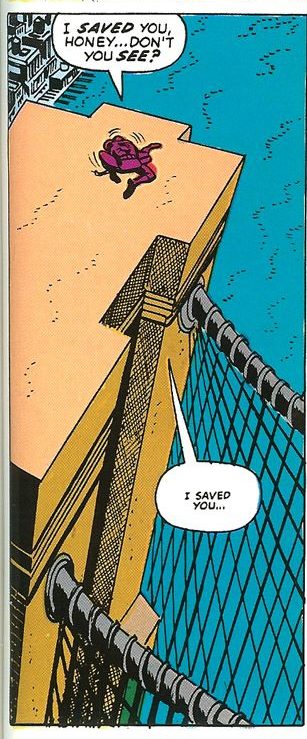
At this point in the comics, Peter Parker was no longer a teenager. He had graduated college, he was an adult. But he was still very much a children’s character. And I find something indescribably tragic about this child’s superhero cradling the body of the woman he loves, unable to comprehend that his world has changed and that the old rules don’t hold true anymore. Good does not always triumph over evil. The innocent are not always spared. The guilty are not always punished. The people you cannot live without will be taken nonetheless. It’s a story about the loss of innocence we all go through and it’s one of very few single issue comics that I would hold up as an absolute work of art. It’s a piece that’s moved me deeply and that I feel a real personal connection to. And I think one of the reasons why it is such a gut punch is because the brutal tragedy at the heart of story is contained in all this colourful, innocent Silver Age goofiness, like a hand grenade with a pink smiley face on it. It wouldn’t work a tenth as well if done in a moody, gritty “realistic” style.
The Night Gwen Stacey Died became an instant classic and to this day is usually considered the demarcation point between the Silver Age and the Bronze Age, a period marked by a more mature and literary style of comics that produced some of the greatest masterpieces in the genre. Unfortunately it also taught a generation of hacks that they could kill the hero’s girlfriend for some cheap drama and pathos. Nowadays, the phenomenon of female supporting characters being killed to provide motivation for the male lead is usually called “Women in Refrigerators”, a term coined by writer Gail Simone after a particularly notorious Green Lantern storyline, but before that it was called “Gwen Stacey Syndrome” because it was really this story that opened those floodgates. To be clear, this does not make The Night Gwen Stacey Died a bad story (or at least, I certainly don’t think it does). The problem is the raft of imitators who failed to realise that what made Gwen’s death so shocking and effective was that it was so rare. Hard as it might be to believe, prior to 1973 women almost never died in mainstream comics, and if they did (Batman’s mother for example) it was almost always off panel. So what does this have to do with The Killing Joke?
Well, The Killing Joke is a 1988 Batman story by Alan Moore with art by Brian Bolland, and since its release its been frequently lauded as one of the best Batman stories, the definitive Joker story and one of the greatest comics of all time. (thanks to Clifford who pointed out that I actually put it on my list of greatest comics which I had completely forgotten). However, it has also increasingly been viewed as being somewhat…problematic…

Why? Well, because in the course of this story the Joker shoots Barbara Gordon, paralysing her, (possibly) sexually assaults her and then shows her father pictures of it in an attempt to break him psychologically. Like Gwen Stacey, Barbara Gordon is brutally assaulted in order to advance the story of a male character, in this case her father and Batman. So there’s quite a bit of backlash against this book, with even Alan Moore himself effectively disowning it. Although honestly, take that with a grain of salt. Despite being the most influential writer in the history of the medium not named Lee, Siegel or Finger, Alan Moore basically now regards the entire comic book industry the way Captain McAllister views the sea.

My feelings? Well…I basically feel about The Killing Joke the way I feel about 99 Problems.
Is it misogynistic? Yes.
Noticeably so for its time and compared to the rest of its genre? Not really.
To the point where it obscures its artistic merits? No.
Of course, reading it now you have the benefit of knowing how the story ends. That Barbara Gordon was able to overcome this tragedy, and became Oracle, a wheel-chair bound superhero who became an inspiration to many disabled comic book fans and one of the most valued heroes not simply in the Bat family but in the DC universe as a whole.
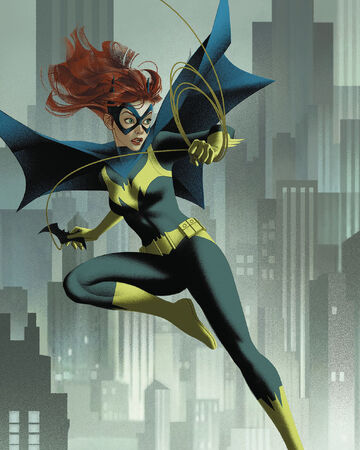
And then Bruce just had her fixed so she could become Batgirl again, which was inspiring to comic book fans with billionaire friends who magically solve all their problems for them.
Ultimately, despite the problematic…

…elements of the story I still think it deserves to be considered one of the all time great Batman yarns. And I was really pumped for this animated adaptation. Look at this line up! Bruce Timm, creator of the legendary Batman the Animated Series was producing, well-regarded Batman scribe Brian Azzaerello was writing the script and the voice cast was shit shot: Conroy! Tara Strong! MARK HAMILL COMING OUT OF RETIREMENT TO DO ALAN MOORE’S JOKER YE GODS!
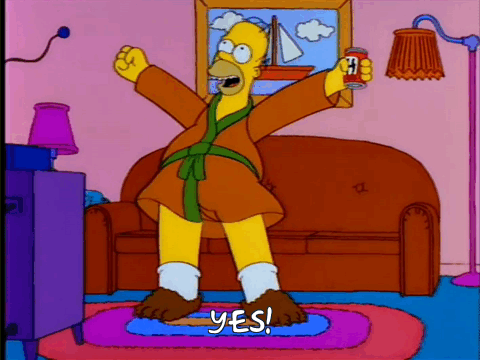
But then early word had it that the animated adaptation would be greatly expanding Barbara’s role in the story and I was leery. I mean, on the one hand, it’s certainly a laudable impulse to want to address criticisms of the original by giving Barbara Gordon more agency and putting her experience front and centre. On the other hand, that is a radical change to the story. Put bluntly, The Killing Joke is not a Barbara Gordon story. Hell, it’s not even really a Batman story. It’s a story about the conflict between Moral Nihilism as represented by the Joker versus Ethical Objectivism personified by Jim Gordon. So my feeling was that if the creators doubted their source material to the point that they would make such a radical change, they probably shouldn’t be adapting it in the first place.
My worry was that we would get a more progressive, more enlightened, less problematic version of The Killing Joke but probably not a better one.
Oh, oh, oh…
I wish that was what we got.
JESUS.
So the movie begins with Batman and Batgirl foiling a bank robbery and okay, hold up. This is something I’ve been thinking about for a while. Do you ever wonder if Batman will become a period piece?
What I mean is, take Sherlock Holmes. Sherlock Holmes started out as contemporary fiction, but most adaptations (most, not all) keep him in his original Victorian London setting because so much of what makes Holmes Holmes is wrapped up with the era. Fogbound streets, gaslight, bobbies on the beat, street tarts asking if you fancy it ducky and Queen Victoria (Gawd bless yer ma’am). Similarly, so much of Batman’s lore and iconography and story-telling tropes are rooted in the early twentieth century. The fact that he has a butler, the fact that organised crime in Gotham is run by families like the Falcones and the Maronis despite the Mafia being a spent force in American crime since the late nineties, Arkham Asylum and of course bank heists. How many Batman stories involve a bank heist and yet they don’t really happen any more. Oh sure, people still walk into a bank with a gun and get the teller to hand over a few hundred dollars from the till. But big, organised, “blow up the safe and drive off with half the GDP of a small nation” bank jobs? Nah. Too risky. Too much CCTV and American cops are now around as well armed as the frickin’ Taliban. So my question is, at some point are we just going to stop trying to update Batman like we did with Sherlock Holmes? When American society has changed so much that it becomes impossible to reconcile with Batman’s world, will we just leave him in the past? Batman the Animated Series had this wonderfully timeless quality where it was never quite clear what era it was taking place in. I bring it up because, as we’ll see, The Killing Joke does not do that and it creates quite a few problems.
Anyway, this bank heist is being led by a young mobster named Paris Franz…
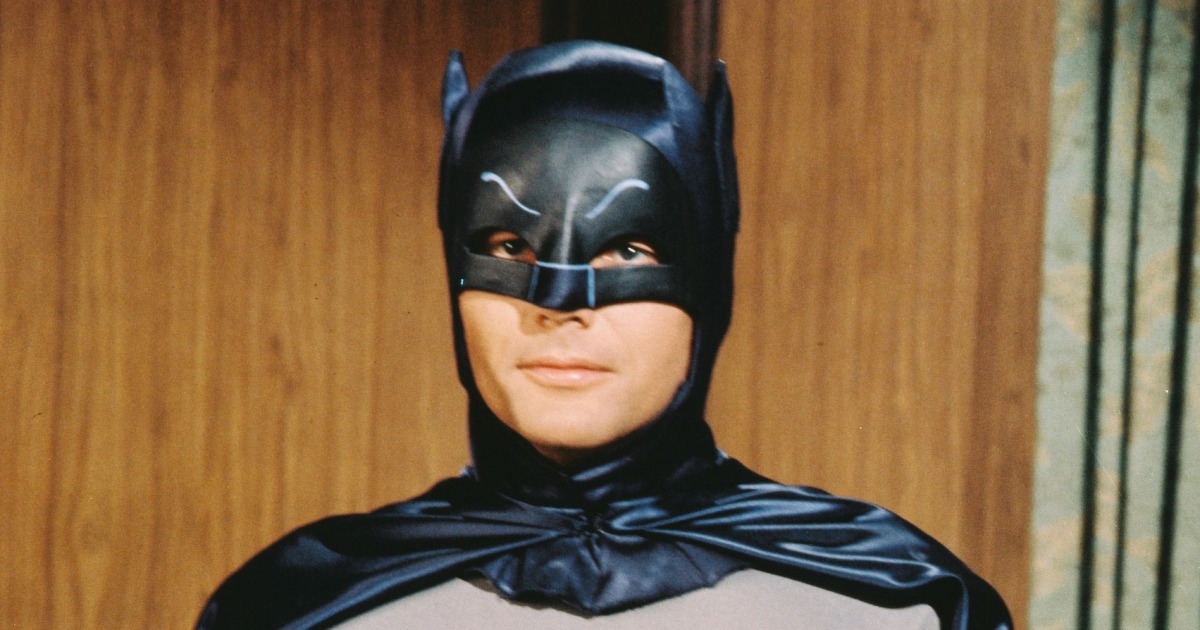
“Now that’s just silly.”
Batman and Batgirl catch some of the robbers but Paris gets away and Batgirl leaves one of the hoods alone with Batman so (it’s strongly implied) he can torture him for information.
Okay so it’s less than four minutes in and this is already the worst Batman movie I’ve ever seen. I know that seems extreme but I stand by it and will not be swayed.
/cdn.vox-cdn.com/uploads/chorus_image/image/45611514/BatmanRobin.0.jpg)
Oh shush, it’s a delightful romp.

Tom Hardy’s voice was cool, shut up!

It…I…but…no…still…worse…somehow…
Paris returns to his uncle who bawls him out for fucking up the heist and losing four men to “the Bat and his bitch” because this is a grown up mature gritty movie for serious grown up people who have proper sex with girls. His uncle tells him that unless he makes good on the money, he’s going to ice him.
Meanwhile, Barbara Gordon is apparently trapped in an ABC sitcom with her gay friend and co-worker, Reese, who is one “you go girl!” away from being the kind of character who would have a been a real trail-blazer in 1992. Seriously, calling him two dimensional would be an insult to circles.

Incidentally, he is also the most layered, likeable and sympathetic character in this entire thing.
Barbara casually shows Reese a programme that she’s been working on for the GCPD which allows them to access all CCTV in the city and basically put all of its citizens under 24 hour surveillance and that’s fine. That’s fine. Nothing to worry about there. Purely by chance she comes across footage of Paris getting out of a car in an alley way, the kind of plot contrivance I would absolutely ignore and give a pass to if this movie hadn’t already burned all of its good will with me like so much dry straw.
Paris tries to rob one of his uncle’s safe houses (an abandoned bank) and Batgirl follows him there. The have a fight and he overpowers her, roofies her with some knock out gas and forces her to lock herself in the vault until he goes away and is then rescued by Batman.

Oh, what a solid fist of bullshit. This is Barbara Gordon. She can wreck two bit hoods like this guy while in a wheelchair.
Anyway, after the police arrive Barbara is watching from a rooftop and Batman shows up with a cup of coffee for her. I do like that, because this version of Bruce is almost Pure Edgelord Batman so I do like this one moment of actually acting like a normal, caring human being. Of course, it does raise the delightful image of Batman queuing in Starbucks
“ONE COFFEE.”
“How do you want it?”
“BLACK. NO PARENTS.”
Batman tells her that Paris is a “nasty combination of psychopath and sociopath” and that he hasn’t had to deal with his kind of crazy in a while. I can only assume “a while” means “within the last twenty minutes” because do you know which of Batman’s foes are crazier than Paris Franz? All of them. Literally every single one. Actuary Man, whose crimes are themed around prudent investments and risk mitigation, is crazier than this utterly, utterly generic douche canoe.
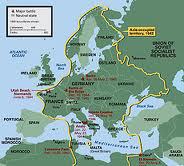
“You made Actuary Man up, right?”

“I mean, I think I did? But with the Silver Age who knows?”
Paris has become obsessed with Batgirl and sends her a creepy video message via the police telling her to meet him where they first met. Batgirl tells Batman that it’s “flattering” and Batman batmansplains that Paris is objectifying her and that she’s off the case because Paris doesn’t fear her and oh my God this script is like the Trump presidency, there’s too much shit happening at once for me to properly process any one particular nugget.
So the movie wants us to believe that Barbara is attracted to Paris and that that’s compromising her ability to bring him to justice. And you know what? That’s fine. Two characters on opposite sides of the law whose game of cat and mouse is complicated by an irresistable sexual attraction? As tropes go its an oldie but a goodie and there’s plenty of good material to be mined from it. Hell, this exact franchise has one of the most successful examples in all of fiction.

But that works because you absolutely understand why Bruce is attracted to Selina. Here though? Paris is such a transparently odious dirtbag that literally the only thing he has going for him is that he’s conventionally attractive, which means that Barbara comes across as a superficial bimbo for feeling anything for him. Even the belligerent sexual tension feels unearned. Listen to some of their white hot verbal sparring as they fight:
PARIS: It’s like a dance!
BATGIRL: Yeah. Right.
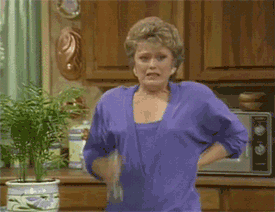
Damn, it’s like Renee Russo and Pierce Brosnan in The Thomas Crown Affair.
And worst of all, it makes Batman’s patronising condesencion to Barbara seem somewhat justified because…she’s kind of coming across like an idiot who’s not taking this shit seriously. Despite being benched Barbara continues investigating and remembers that where she and Paris first met was his getaway truck from the bank robbery and not the warehouse where they fought. She finds the truck in an impound lot with a smartphone waiting for her with another message from Paris. This leads her to his uncle’s townhouse where she finds Paris’ uncle murdered. A load of goons swarm in with guns blazing and Barbara has to be rescued by Batman again (such empower).
Time for another rooftop scolding, where Batman tells Barbara “We may be partners but we’re not equals” because, get this, Barbara hasn’t been taken to “the abyss, the place where all hope dies”.
Holy shit. Holy…
Okay, first of all:

Secondly, this movie came out in 2016 like all the rest of the world’s evils when Pandora opened that fucking box. Who the hell still thinks this version of Batman is still relevant or needed? The idiotic “Trauma is my superpower” version of Batman has been parodied to hell and back at this point. Guys, this is a post Lego Movie world, no one can take this shit seriously anymore.
Secondly, I don’t know who either of these two people are but they ain’t my Batman and they ain’t my Batgirl.
Batman and Batgirl have a very different relationship from, say, Batman and the Robins. Barbara Gordon didn’t have a personal connection with Bruce Wayne, she wasn’t adopted by him after her parents were killed. She simply saw what Batman was doing, saw that it was making Gotham a better place and said why not me? I think it was Chris Simms who said that Dick Grayson represents Batman’s greatest triumph as a person, but that Batgirl represents Batman’s greatest triumph as an idea. It’s like that great scene in Batman Begins where Bruce is talking to Alfred of the power of Batman as a symbol. Barbara Gordon is that power in action. So the implication of this scene, that Batman thinks Barbara can’t be a hero because she hasn’t been hurt enough is hot garbage. It’s basically Batman taking a long asparagus piss on his own life’s work.
Furious, Barbara throws a punch at Batman and they start fighting and then she knocks him to the ground and then and then…

OH GOD NO NO NO.
Yeah. So. Batman and Batgirl get fucked.
Oh, and they also have sex.
So much wrong with this. The age difference. The power differential. The fact that it’s his best friend’s daughter. Who wanted this? Who asked for this? Who the fuck thought this was a good idea?
So. After that. Bruce starts avoiding Barbara who deals with this in a mature and mentally stable way by grabbing a random dude and throwing him head first over a hedge when she hears him arguing with his girlfriend. Not, like, threatening his girlfriend or verbally abusing his girlfriend. Just telling her that she’s being clingy and that he needs some space. And Barbara, the police commissioner’s daughter, just randomly assaults this dude which I’m sure would have no repercussions.
Serious question, am I being trolled here? It’s like they had a list of all the complaints people had about the original comic and a list of all the things people loved and wanted more of and they somehow got switched.
Anyway, after a scene where Batgirl basically begs Batman to take her back like she’s calling from a bar at 4 am, she goes down to the docks where Batman is looking for Paris. She’s able to save Batman from Paris after he blows up the Batmobile. She drags Paris behind her motorbike before flinging him to the ground and beats the shit out of him while screaming “SELFISH! VILE! PIECE OF GARBAGE! YOU RUINED EVERYTHING!” in what I can only assume is a case of mistaken identity.

“Paris? Oh shit, sorry, I thought you were Brian Azzarello.”
So Paris is arrested and this concludes the Barbara Gordon section of the movie, where we learn that Barbara Gordon stopped being Batgirl because she realised that she just wanted to have sex with Batman and is too darn emotional for the job.

“There. That oughta keep those feminists happy. Now, on to the real story!”

“No. No! No I don’t wanna!”
Like, sure, the rest of the movie is going to be using Moore’s original story as its basis so it has to be better but…
Invite me to a three course meal and force me to eat literal shit for the starter, it doesn’t matter how good the main is. I. AM. NO. LONGER. HUNGRY.
Alright, so Batman is called to the scene of a multiple homicide. Several dentists have been found murdered in an abandoned stand-up comedy club with massive grins on their faces so no prizes for guessing who was responsible.

Oh you think you’re so funny, don’t you? Real buncha smartasses.
Batman visits the Joker in Arkham Asylum and get the iconic scene of Batman trying to reason with the Joker while he just sits there silently playing solitaire.

I’ve always loved this scene. It’s almost like the obverse of the scene in The Dark Knight where Heath Ledger’s Joker tells Batman “we’re going to be doing this forever”.
But for Batman, they can’t do this forever. He knows that if he and Joker can’t break out of their constant cycle of escape, atrocity, battle and capture, sooner or later one of them will die. And he can’t let that happen without knowing that he tried, at least once, to reason with the Joker.
Unfortunately, the scene doesn’t translate well to screen for two reasons. Firstly, the dialogue is entirely unchanged from the comic. But in the comic, this is literally the first scene. Batman, as far as we know, has come to Arkham to talk to Joker and for no other reason. But because we have that scene before of the discovery of the bodies, you’re just sitting there waiting for Batman to say “so, about all them dead grinning dentists. I’ve narrowed it down to you and Condiment King, any thoughts?”
Another problem, and it just breaks my heart to say: Kevin Conroy and Mark Hamill are both kinda crap in this.
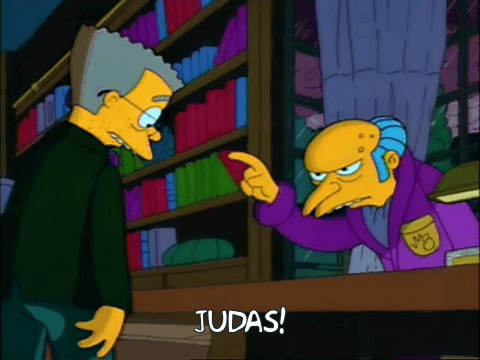
I know, I know, but honestly it’s the truth. They’re both so checked out.
Conroy sounds like he’s voicing a Batman themed GPS system and Hamill just sounds tired, angry and frustrated, like he’s done with the whole sodding business.

Anyway, it turns out that the person Batman is talking to is not the Joker but a double the Joker has apparently paid to impersonate him by sitting at a table playing cards for the rest of his life (nice work if you can get it).
So yes, in a shocking turn of events, the Joker (get this!) has escaped (no!) from ARKHAM ASYLUM! (HEAVENS TO MURGATROYD!).
We cut to the Joker touring an abandoned amusement park with the owner. Joker tells the owner that he’ll take the piss-soaked death trap off his hands and then kills him. We now get a sepia-toned flashback where a struggling stand-up comedian (we’ll call him Joe) comes home to his heavily pregnant wife in their tiny apartment and tells her that he’s blown another gig. She tells him that she’ll talk to their landlady to get an extension on their rent.
This scene, for me, is one of the most important scenes in the comic because it establishes that the Joker is full of shit. In his own telling, the Joker was a good, ordinary man who was driven mad by “one bad day”. His point being that anyone could become him under the right circumstances.
But here’s the thing. He’s not a good man. He never was. Joe mightn’t be a mass murdering Harlequin of Hate, but he is evil in a far more banal and every day way. He’s emotionally abusive and manipulative and masks it with performative displays of helplessness. He quits a stable job to pursue a career in a notoriously low-paying and irregular profession which he has little or no aptitude for which would be fine if not for the fact that he’s got a wife with a baby on the way. But, you know, he’s gotta follow his dreams.

This fucking guy.
This movie brought home to me something that I hadn’t realised before. The success of the original Killing Joke owes as much to Brian Bolland’s art as it does to Alan Moore’s script. Reading the comic again for this review, I was actually kind of shocked at how fantastic the artwork was, and a little ashamed that I had been thinking of the story as solely Moore’s creation.
Specifically, I’m talking about the original artwork, not the re-mastering Bolland did a few years back rendering the story in a more muted “modern” Batman colour scheme.
/cdn.vox-cdn.com/uploads/chorus_asset/file/6861621/KillingJokeCompare02.0.jpg)
I don’t hate the re-master, it’s technically very fine. But like with the death of Gwen Stacey, I think that the visual irony of this story of terrible human suffering being rendered in these garish Silver Age colours gives it a lot more impact.
Anyway, one of the reasons that the story is such an absolute gut punch is Bolland’s gift for faces. Look at these.

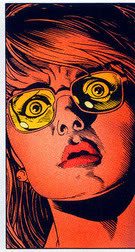

Look at the clarity of emotion that he’s able to wring out of these lines. Just phenomenal.
Now look at this scene where Joe has just learned that his wife and unborn child have died in a tragic accident.

The art style that this movie’s has gone for, a kind of chintzy “Batman the Animated Series but with all the simplicity and none of the charm” is just too basic for this story. This is a tale about human beings broken by the cruelties of random fate. The main action is all emotional. And in this movie, the characters expressions can’t convey the emotion needed to make the story compelling.
And every so often they’ll try to recreate an iconic panel from the comic and just switch to a more detailed style and it’s really, really jarring.
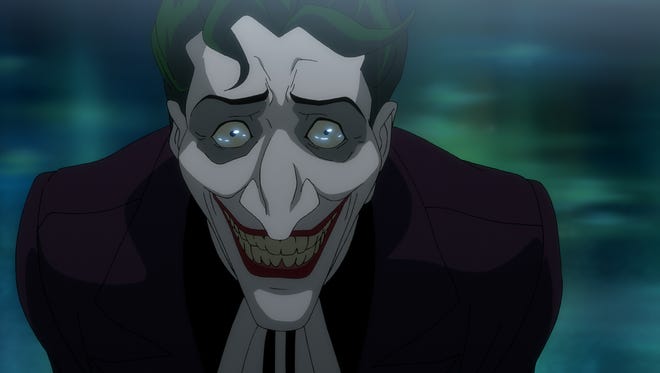
Back in the present the Joker and some of his henchmen raid Jim Gordon’s home. Barbara is shot and paralysed and Commissioner Gordon is kidnapped. The scene ends with Joker undoing the buttons of Barbara’s blouse and telling her that it’s “to prove a point”.
We get another flashback where we see Joe agreeing to help some mobsters rob his old employer, a chemical factory. So here’s another thing about this movie that only really bugs me because of the stupid, illogical Paris Franz business they stuck on the front half of the movie. Here are the mobsters, visually faithful to the original comic:

I mean, those are some old-timey gangsters, right? I don’t claim to be an expert on fashions but I wouldn’t expect to see people dressed like that later than the 1930s. Early forties, maybe. Why does this bug me? Because the Barbara Gordon/Paris Franz plot makes heavy use of a smart phone, placing it very much in the 2010s. Which means that if Joe and Batman are both in their early twenties in the flashback scenes, they’ve gotta be around 90 to 100 years old for the scenes set in the present. And look, this would absolutely work if, like Batman the Animated Series, the movie took the time to establish a timeless never-when setting. But this is just bad internal continuity.
Back in the present, Batman visits Barbara in the hospital and learns that she’ll never walk again. Barbara wakes up tells him that the Joker has something planned for her father, something worse than he’s ever done before and begs Bruce to save her Dad. Alright, indulge me. Here is that scene in the movie.

Here is the same scene in the comic.

Exhibit A: A man in a bat costume peering down at a brutalised woman like she’s a fingerprint under a microscope.
Exhibit B: A human being trying to comfort a friend whose just gone through an unimaginable ordeal.
And I know. It’s a small thing. It’s a small thing. But do you know what a character is?
Small things.
Batman goes on the warpath tearing up a local mob hideout that actually looks more like a casual burger joint.

What a bunch of uncouth toughs. I hope Batman beats them thoroughly.
The generic unnamed vaguely Mafia-esque guy who runs it tells Batman that he hasn’t seen the Joker and he’d tell him if he had because regular criminals hate him. And that’s it, that’s the scene.
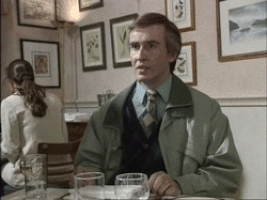
We now get a scene where Joker and his gang of freaks hold a mock trial for Gordon and demand to know what should be done to someone who brutalises people who get in his way and has no regard for the law. Thinking that they’re talking about the Joker, Gordon of course says that such a person should be locked away but OH WHAT BITTER IRONY IT TURNS OUT THEY WERE ACTUALLY TALKING ABOUT BATMAN OH HOW WONDERFULLY SUBVERSIVE.
So. Get this. The movie wants you to consider that maybe, just maybe Batman is the crazy one and Gordon is a hypocrite for working with him.
Oh, what a fresh new take.
And look, the hypocrisy of Jim Gordon, supposedly the one good cop in Gotham, relying on an illegal vigilante is definitely a valid point to address (and only has been, like, seven or eight thousand times) but this is really not the story to do it in. If the Joker doesn’t actually believe Jim Gordon is a pure soul and the personification of law, justice and ethical objectivism then he wouldn’t be doing any of this.
Back on the street, we see Batman interviewing some hookers so we can learn that they don’t know where he is either and also that the first thing the Joker usually does when he gets out of Arkham is have sex with a load of hookers and excuse me I just need to drink some bleach until my thalamus can no longer create mental images.
So the last three scenes I’ve just described are all original to the movie. So I have to ask something.

“Brian Azarello?”

“Yeah?”

“How much money did Warners pay you for this script?”

“Uh, that’s really none of your…”

“GIVE IT BACK.”
Seriously, I’ve seen bad movie scripts but this is barely even a script on a functional level. And look, the original comic is barely fifty pages long. I get that it needed to be expanded. But this is just dumping shit on to make up the time. The mob hideout scene is pure filler. We don’t learn anything except that ordinary crims don’t like the Joker which doesn’t factor into anything and doesn’t advance the plot one iota. We have the trial scene which actively weakens the story. And lastly we have this, which is just nonsensical and gross. The scene is based on a single wordless panel in the original which is part of a one page montage of Batman searching Gotham for the Joker.

And it makes perfect sense, because if there’s a serial killer on the loose sex workers would definitely be keeping their ear to the ground because it’s kind of in their best interests to know about that shit. There’s never any suggestion that the Joker is a regular client because what kind of hooker is going to sleep with an instantly recognisable murder clown with a three figure body count? And lastly…no. No, that is not the first thing the Joker does when he gets out of Arkham. He’s not going to cheat on Batman, what do you take him for?
Meanwhile, at the fairground, the Joker is trying to break Gotham psychologically by putting him on a ghost train and showing him pictures of Barbara being violated. It’s awful, but honestly, after four plus decades of writers pushing the Joker to ever more ridiculous and over the top displays of barbarity, the idea that this is the worst thing the Joker has ever done is almost quaint.
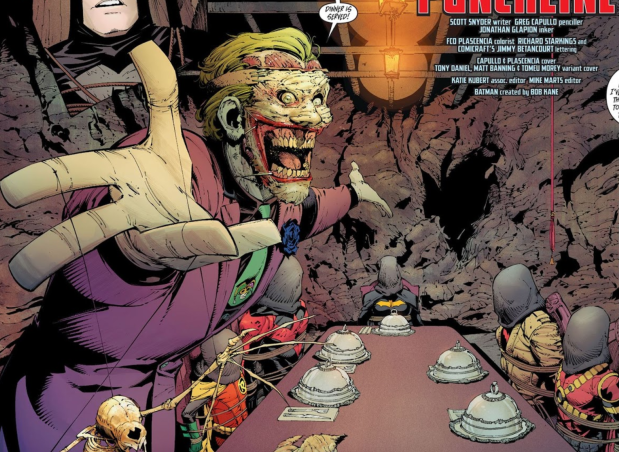
Don’t ask. Just don’t.
In flashback we see how Joe was forced by the mobsters to dress up as the Red Hood when they went to rob his old place of work, which turns out to be a chemical plant with some really lax safety standards. Batman showed up, Joe got knocked into the chemicals, went crazy, one bad day, yadda yadda yadda, you saw how it went down in that much, much better Batman movie.
Batman finally tracks Joker down and rescues Gordon. Gordon tells Batman to bring Joker in “by the book” and Batman heads off in pursuit of Joker.
Batman tells Joker that Gordon hasn’t been broken and that he’s wrong about everyone being like him and that’s he’s just a jerk, so there.
Joker pulls a gun on Batman but it turns out to be just a gag weapon. Exhausted, he throws the gun away and tells Batman “Well go on. Beat the hell out of me and get your standing ovation.”
We now get the one scene in this that actually works. Where both Conroy and Hamill actually seem invested and it approaches something of the power of the original. Batman tells Joker that he doesn’t want to hurt him and that, like him, he also had one bad day. For once, he offers to listen to what Joker has to say. And to help him, if he can.
And Joker…actually seems touched by this. He turns down Batman’s offer, saying it’s too late. The movie ends with these two desperate enemies finally able to find a tiny moment of shared humanity.
Oh, and there’s a mid-credits stinger of Barbara Gordon starting her career as Oracle.

Oh well. Movie saved, then.
***
Alright, so that’s 6,000 words ripping on other people’s hard work. What would I do differently?
Well, glad you asked. You didn’t ask. I know that. But it’s my blog and there’s no escape.
Okay, here’s how I’d adapt The Killing Joke:
Firstly, crazy idea here, maybe have the first half of the movie have some thematic, narrative and logical connection to the second half of the movie? I know, I know, I just get these bursts of genius striking my head like thunderbolts from the heavens.
You start the story immediately after the death of Jason Todd at the hands of the Joker. Batgirl and Batman are pursuing him through the city and Batman is…not doing so good. When they finally track down the Joker, he of course, uses Todd’s death to troll Batman and Bats JUST LOSES IT.
He comes closer to killing Joker than he ever has before and Barbara has to knock him out before he breaks his no-killing rule.
Barbara then subdues the Joker and we learn that it’s actually Batgirl who put the Joker away at the start of the Killing Joke. Barbara then tells Bruce that she’s quitting because she can no longer trust that he’ll always do the right thing.
And then, Batman goes to Arkham to kick off the Killing Joke part of the movie which now makes greater narrative asense because Batman is not just going to try and reason with the Joker apropos of nothing. Now, when he says “we’re going to kill each other, aren’t we?” we the audience know how true that is.
And we’re off to the races. Now, when Batman brings Joker in by the book, he’s not just being inspired by Jim Gordon, but also by Barbara.
Boom. Barbara Gordon has a greater and more active role in the story, not as Batman’s stalkery one night stand but as a valued partner and friend who inspires him to be a better man. And the plot now has a structure that doesn’t resemble two fat gerbils awkwardly stitched together.
Animation: 05/20
Stiff, unlovely animation and bland, inexpressive character models.
Leads: 04/20
Holy character assassination Batman!
Villain: 06/20
That’s all it takes to ruin a character. One bad movie.
Supporting Characters: 08/20
Paris Franz has this one English bodyguard. We never really find out what his deal is, or what a Londoner is doing in Gotham working for the mob, but he’s honestly kind of appealing so I’m throwing the movie a bone here.
Music: 07/20
The main score is perfectly acceptable creepy Batman fare. And I appreciate that they actually tried to put in the Joker’s song from the comic as a full musical number. In theory. I appreciate it in theory.
FINAL SCORE: 30%
NEXT UPDATE: 23 July 2020
NEXT TIME: So remember the old days when I thought endlessly repeating a movie line counted as comedy? Well, did you ever dance with the devil in the pale moon light?
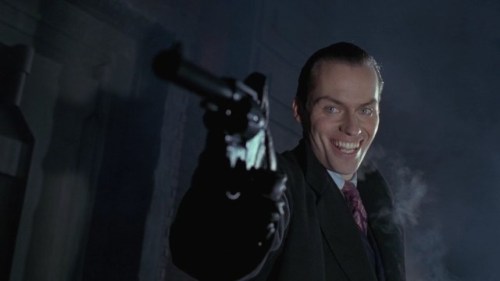
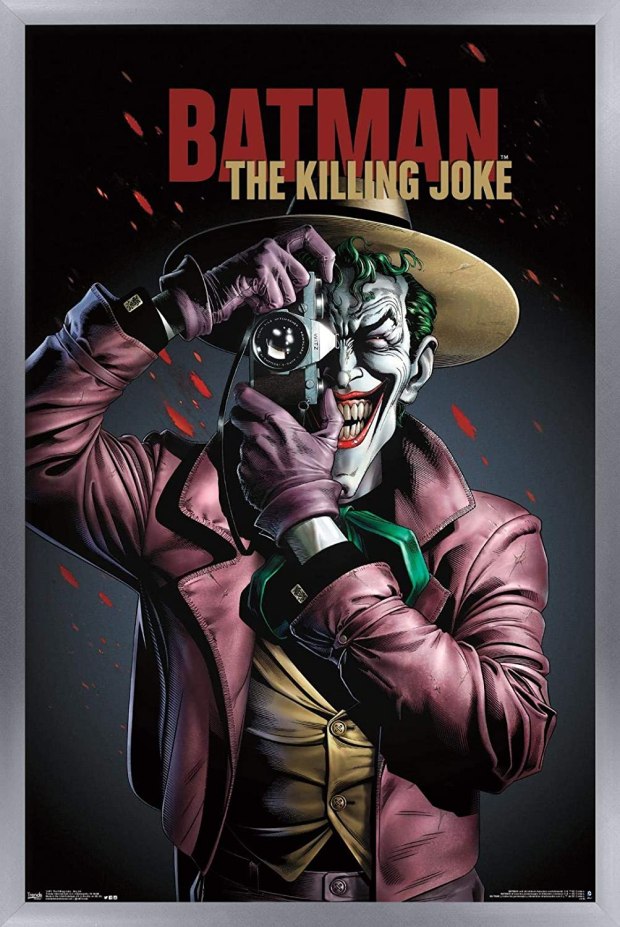
I like your idea for how you could change the first half of the movie to fit better with the second half.
But honestly, I wouldn’t have a first half at all, I’d have made it a short and just kept the comic-accurate stuff. And that’s not because I consider the comic a sacred cow that shouldn’t be tampered with (it’s a classic, but like you said, problematic).
But I truly like the idea that Batman just went to Arkham one day to try to connect with the Joker. I could see that speech in the first scene being something he practiced in his head a hundred times, over a hundred different nights brooding next to gargoyles, wondering if there was any hope for peace.
That he made that gesture under his own steam, rather than in reaction to the Joker’s latest atrocity, says something about Batman. Something that doesn’t at all mesh with this movie’s “tortures thugs, belittles Batgirl, and then bangs her” Batman, so no wonder they changed it.
Batman’s coffee order made me legitimately choke on my own coffee, so thanks for that. I could only read that line in Linkara’s Batman voice. And I can’t wait for your Batman ’89 review.
Your version of the introduction is a sound hypothetical rewrite. It gives agency and purpose to all characters leading up to The Killing Joke. If given the opportunity to write said script, the introduction to the movie would be one of the following things:
1) Put the focus on the relationship between Batman and the Joker. Use the beginning to show how a clown who was a grim killer (or some kind of a mixture between Batman #1 and The Man Who Laughs by Ed Brubaker) would evolve into something more docile before incorporating the fallout from the death of Jason Todd. You use good points to show a Batman who is angry and hurting who, either in your interpretation as on the edge of killing him to tie into the potential ambiguity of the ending or as somebody who is tired and wants to move on but can’t as he is a slave to the mission, would go to Arkham to initiate the beginning of the graphic novel.
2) Give a proper send off to Batgirl in her last case. If you do not want to include Barbara Kesel’s Bagirl Special, perhaps have Barbara pursue Harley Quinn in some capacity (which does fall into the pitfalls of putting two female characters with each other). However, it would tie into the one moment from this adaptation I appreciated for this particular medium: while Brian Bolland was able to adapt Dick Sprang’s artwork for the scene in the Batcave, the film changed it to famous moments in the Joker’s film history, including a shot of him and Harley Quinn.
But hey, at least Mark Hamill got to sing.
Okay, are you actually Grant Morrison don’t make me beg.
When it comes to the work of Mr Alan Moore I find that a little goes a long way; more accurately I enjoy some few of his works without qualification and find the others … troubling, hence my uncharacteristic decision to make d— sure the plot of any given Moore work is something I’m well aware of before going in (and Mouse, I normally shun Spoilers the way you shun the Oxford Comma).
Given I actively prefer THE LEAGUE OF EXTRAORDINARY GENTLEMAN film to the original comic (which I respect, though the sequels are increasingly unappealing to the point of being quite appalling) and am sometimes tempted to regard FROM HELL & V FOR VENDETTA in much the same light, it’s interesting (or just possibly … interesting) to learn of an adaptation of Mr Moore’s work so appallingly worse than the original that THE KILLING JOKE looks downright loveable by comparison (and the latter is by no means my favourite Moore – that Honour going either to SUPREME or TOM STRONG, although TOP 10 presses its claim with some puissance).
I most definitely think that your concept for a KILLING JOKE adaptation is extremely strong, Mouse, even leaving aside the rest of the essay – the connection between poor Jason Todd’s death and Joker’s assault on the Gordon Family is horribly, horribly apropos.
Out of curiosity, may I please ask how you would define the aesthetic of such an adaptation? (My own suggestion would be to aim for a slightly less timeless non-specificity than that seen in Batman the Animated Series; the flashbacks taking place in a slightly more 1940s aesthetic, the ‘present day’ sections having more of a 1980s feel – perhaps a simpler definition would be that the ‘present day’ sections treat as Retro-style what the flashback sections treat as modern life).
Finally, another person on the internet who likes League of Extraordinary Gentlemen!
ISOLATE THEM NOW BEFORE THE MADNESS SPREADS
Oh wow, I thought I was the only one. I’ve never even read the comic (nor do I intend to), but I recently re-watched it on Netflix after several years. Can’t say its a good film, yet I liked it as much as I did the first time.
p.s. Mouse – I hope that your family have been doing well? Please do extend my Best Wishes to your own clan and please accept my kindest regards on your own behalf.
Extra post-scriptum: I look forward to seeing your effort to make the ‘Music’ scalestop short of a perfect 39 for Mr Danny Elfman’s most deservedly iconic Bat-score! (also, if you’re looking to defend BATMAN V SUPERMAN as a better film than some all you need are two words – WONDER WOMAN, laddie!).
In all honesty it will be interesting to see your assessment of Mr Burton’s Bat-flick, which I would argue is a pretty darned good Superhero movie but a somewhat qualified success as a faithful rendition of the Dark Knight (at least as I prefer to see the character depicted).
Still, I trust that Intrepid Reporter Alexander Knox and the late, great Michael Gough (as quite possibly the most adorably fatherly Alfred Pennyworth ever committed to screen) will oomph up the ‘Supporting Characters’ score likely let down slightly by Mr Pat Hingle’s sound, but somewhat marginalised Commissioner Gordon and a thoroughly underused Harvey Dent (aka Mr Billy Dee Williams himself himself).
Also, I’m rather assuming that Two Jacks (Messers Palance and Nicholson) will furnish a reasonably strong ‘Villain’ score; if nothing else the formers inclusion in the film allows us the happy, happy mental image of Jack Palance as a more spectacular Batman villain – Two Face? The Joker, even? Certainly he worked on at least two television series in 1966 and one of them was THE STRANGE CASE OF DOCTOR JEKYLL AND MR HYDE (which I hope we can all agree is Batman-adjacent!).
Well I have a lot to say. I smiled real big when Joker shot Barbara. I was rooting the entire movie for someone to do it.
Part of the excitement for this movie is that the DC Animated Original Movies lineup had been in a dark Age since since War, and most fans thought this would end it (ignoring that Killing Joke is not good movie material). Instead it is overall their most hated work even today by far, and every time it is announced Bruce Timm is in charge many of the comments are saying they are scared it will be another Killing Joke.
My way to adapt the story would be to ditch the prologue idea, and try to emulate Superman vs. The Elite, another movie based off a single issue. Add character focused scenes throughout the narrative. Add a flashback of the first time Joker battled Batman, flashback of Barbara becoming Batgirl, flashback of Jim telling his young daughter about Joker and Batman for the first time (maybe animate her nightmares), Joker murdering his former landlady, etc.
I have seen worst Batman movies since the ending and Hamill gave me enough enjoyment, but this is the third worst one I have seen.
What’s 1 and 2?
Son of Batman (generally a hated movie) and its sequel Batman Vs. Robin (a love it or hate it movie that unfortunately I hate).
There’s one Batman villain (sort of) called The Actuary, actually. He worked for the Penguin, helping him with the logistics of his crimes, and had appearances in two comics of the nineties, despite having the least nineties appearance a comics character can ever have.
If I’d been asked to make this movie… I think it’d have been an anthology movie, that’s the only way to fill a whole movie runtime with the rather simple plot of Killing Joke. Adapt the Clayface tale by Alan Moore about the mannequin and the other Batman tale by Brian Bolland about the delusional guy dreaming of killing Batman and you’re done, really. Maybe expand the scene in the comic where Batman questions the Penguin, by setting it in his nightclub or hideout instead of a cell, and they can have a fight to fill space, that might work.
Or better yet; make Killing Joke the first half, and the second half adapts that brilliant Batman Chronicles by John Ostrander and his late wife Kim Yale on how Barbara Gordon became Oracle after being crippled. That way you can take Barbara and give her a closure, a chance to redo her life.
I’m sorry, I see how all the other points date Batman, but… having a butler? Rich people still have servants, so… I don’t get it, maybe I misunderstood and you meant Bruce has a single aged butler to take care of a whole huge manor, drive his limo, cook his meals, wash and press his clothes, tend to his gardens, fix his wounds, clean the guano off the cave and feed Ace the Bathound? Then yeah, that ages the whole thing badly since we stopped hiring superhumans back in the sixties.
The re-master of the color in the comic improves the Batman scenes, but hurts the Joker scenes, which is bad because Killing Joke, as you said, is not really a Batman story but a Joker story. As a Batman story it’s kind of crap since it’s a story that requires the World’s Greatest Detective to receive an invitation so he can figure out his clown nemesis may be hiding in an old abandoned fairground while looking literally everywhere else for him. As a Joker story, it’s brilliant, but the striking, demented colors of the original fit the Joker much better than the reinterpretation, which work best for the more (comparatively!) ‘down to earth’ Bruce.
The Killing Joke’s true point which even Moore seems to ignore is the conflict of Joker’s point against Batman’s point. That of life being absurd and pointless versus that of having to enforce some measure of control and justice over life’s unfairness. The Joker, in a way, is right in that the world is monstrously cruel, insane and unfair, but he’s wrong in that we have to accept it as such and fall with it. Like Batman himself says in the other big misunderstood and misinterpreted comics hit of the eighties, Dark Knight Returns, the world only makes sense if we force it to. A never ending battle, to steal a phrase from another hero, but a necessary one.
And in a way, there’s no bigger theme to make from life than that. Life may be perverse and nonsensical, but we have to keep fighting the good fight regardless.
More that Alfred is very much in the mode of an Edwardian gentleman’s personal gentleman and seems very out of place in a 21st century setting.
I think he was even out of place when he debuted in 1943; if I recall, his original origin story was that his dying father asked him to carry on the family tradition of serving the Waynes, and so he just turned up on Batman and Robin’s doorstop and announced that he was their valet now, whether they liked it or not.
Considering the time period, it actually makes sense that Bruce’s father or grandfather might have had a personal gentleman like that, but Alfred was arguably an anachronism to begin with, and has become even more so over time.
And here I was thinking Actuary Man was just the Calculator’s more successful cousin.
Learning that the Actuary is real made my goddamned day.
I forgot to mention, in the comic, didn’t the dialogue imply ‘Joe’ didn’t know his wife was pregnant when he quit the job?
Even though they are hazy and most likely false memories it’s not like they are a result of the Joker really making excuses for himself and making himself look good; he’s still thinking of himself as a loser and failure, so in a way they might be seen as a way of Joker, under his sick narcissism, actually hating himself, which would also jive with how willing he is to risk his life at any given time.
Great review, Mouse. Better (and longer) than I could’ve expected. (And you didn’t even include the part where they screened the movie at Comic-Con, the audience went “WTF was that”, and Azzarello responded by calling his critic a pussy. The Killing Joke! The gift that keeps on giving.)
– I was gonna bring up the bad VA performance if you didn’t. I had poor hopes for the movie, but I thought, “Okay, the art style and frame rate is terrible, half the movie is pointless filler, the conversation around it is gonna be as venomous and terrible as ever, but at least Conroy and Hamill are going to do good enough that somebody could make a good audio drama out of their performance.” And…that didn’t pan out, and I think the movie is totally unsalvageable for it.
– I really love the Killing Joke as a book, and I’m turning out to be a crabby old curmudgeon who doesn’t want to toss it in the dustbin of history like so many people seem to want nowadays. So I’ve been thinking of how to fix this thing so we can keep it, and I think I figured out a way to tell the story while keeping the meat of the story while cutting out the part that pisses everybody off:
Replace Barbara Gordon with James Gordon Jr.
Junior is a weird artifact of Batman lore. As far as I can tell, he’s made all of three notable appearances and he really should have been Barbara for two of them:
*He’s Gordon’s first-born son in Batman: Year One. This screws up the timeline something fierce, since by the time Barbara is born and is old enough to run around in a costume, Batman should be pushing his age in DKR. As near as I can tell, this happened because it was Post-Crisis, all the old Canon had been swept away, and DC editorial seemed to hold Batgirl in a stupid kind of contempt, hence her dismal role in The Killing Joke. “Batman for girls?! We’ll NEVER be able to turn that into a million dollar costume and toy enterprise!” Like I said before, should’ve been Barbara.
*I’m pretty sure he’s the kid from The Dark Knight. Small boy who sees Batman in action and is inspired by it? Again, should’ve been Barbara.
*I haven’t read The Black Mirror, but apparently that’s about how Junior turned out to be a serial killer. It’s supposedly a good story, but it’s also a one-off, it’s the only thing Junior appeared in to have a memorable role in, and I’d be impressed if it doesn’t get retconned by some future reboot somewhere down the line.
So, basically, he’s kinda disposable in my eyes.
So next time we do this story, Barbara is Batgirl, and James Jr. is her kid brother, and he fills Barbara’s role in the original story. Everything else plays out as before.
The story remains the same, but I think it works better. Gordon’s kid is still being targeted, but now Joker’s worst plunge into depravity is even worse because he hurt a child, not an adult. There’s less chance of creepy grognard assholes being titillated by seeing Junior naked and bleeding on panel. And now this grudge match that DC keeps trying to push between Batgirl and Joker, which just pisses Batgirl fans off even more because it rips open old wounds and reminds them of their favorite character’s worst moment, has a better reason to exist, because Batgirl is now actively fighting the urge to avenge her brother and kill the clown. Maybe Joker switches from barely noticing her to trying to work on her mind, since she seems like an easier job of turning to the Dark Side.
And best of all, everybody enjoys the story and nobody’s angry (well, I’m sure SOMEBODY is because Twitter) because Junior is nobody’s childhood hero. There are no James Gordon Jr. dolls, there are no inexplicable pink James Gordon Jr. Halloween costumes, and no 8 year old girl has to grow up watching James Gordon Jr. in children’s cartoons, only to reach adolescence and find her favorite character has a sordid misogynistic backstory that turns her off of comics for good.
It’s a big change, but this is the studio that saw fit to give us Paris Franz and make a Hush movie where Hush is not Hush. I think it’s doable.
– In regards to superheroes becoming dated, well, this comment might not age well, but I think we might just about be there. The murder of George Floyd’s got a 9/11 feel to it for me. There’s this growing since of “before” and “after”. An innocent man was killed, America has suddenly become aware of a great evil, and now everybody’s gung ho about fighting it through any means necessary, and if you aren’t on board with some of these methods, then somebody will be screaming at you, calling you a traitor, and saying “THEN THE FASCISTS HAVE ALREADY WON!” (All I’m saying here is, I dunno what we do if we abolish the police. It might turn out to be necessary for all I know, but I’m positive the outcome won’t be sunshine and rainbows.)
Our culture is changing rapidly to adapt to people’s raw nerves over the police, just like it in regards to terrorism did in the aftermath of 9/11. Brooklyn 99 had to scrap its next season’s scripts and it’s not clear right now if the showrunners think the show’s got a future in a world where half of America thinks police are inherently evil. Since the current management at the Big 2 comics publishers self-identify as fairly progressive, I expect to see big changes to their characters and their relationship with police over the coming years, and I straight up don’t know if some characters like Batman are gonna make it. I think the fascists have done in poor Punisher already.
I just don’t know.
It’s worth remembering that George Floyd’s death, sad and regrettable as it is, is an event that has marked the United States of America, not so much the rest of the world, which, shall we say, has more pressing and urgent problems right now.
I don’t think that regrettable issue the States have with the concept of authority figures imposing order is that much of an issue yet with the rest of the world, which, well, comprises most of mankind after all. I believe that globally the idea of the superhero as a guidance and inspiration light for a world in need of strong values and idealism is still valid.
I’m kind of intrigued, actually, by how much people of the US of A seem to focus so much on their own society and then taking for granted whatever they are feeling at the moment in any given situation is also by default the standard position of the rest of the world. In a way, it seems to me, that’s still another, if relatively better intentioned, facet of the old ‘the ugly American’ problem, that of the USA thinking their issues at the time are everyone else’s issues. Globalization hasn’t really done much to put us all in the same wavelenght after all.
Yeah, I’m immediately regretting bringing up current events, because I’m sure this won’t go well.
Basically, my point is that, whatever the rest of the world thinks, American superheroes are an American product and are gonna be swayed by whatever the public mood of Americans is at any given moment. If Americans don’t like police period – which is the vibe I get right now from the Americans who make content at Marvel and DC at least – that’s gonna affect the way they write their characters, which trickles down to every other country that consumes their content.
And I dont personally think all cops are bad. But things are…testy here in the States right now, and saying stuff like that is a great way to start an internet cage fight with a stranger. Which I’m not interested in.
I’ve been saying this for a while now. We (non-Americans) need to stop taking our cues from the states and thinking of our problems through an American lens. Because (no disrespect) America is fucking crazy.
I mean…It has been a fairly major element of the mythos that Gordon is literally the only cop in Gotham who isn’t corrupt, and probably would have died mysteriously a long time ago if Bats wasn’t around.
No, to be fair, characters like Montoya and even Bullock are actually good cops. Sure, Bullock may bend the rules to get results but other than his first few appearances where he really was corrupt, he actually has good intents in mind.
If Gordon’s pretty much the only good person working in an official manner to do good for Gotham, it beats the purpose of Gordon trying at all to start with, since Gotham’s all but unsalvageable and basically the Joker’s right.
He starts OUT as the only good cop in Gotham. In a world without Batman, he’d be have been shot in the back of his head in a parking garage by a “fleeing suspect” (Read: One of his fellow colleagues.), but, with Batman’s help, he’s able to get some genuine reforms done.
Ugh. Punisher was always pretty irredeemable in my opinion. Have him as a supporting character or a villain but not a hero.
Right on! I’ve never understood how an actual spree killer functions as anything but an anti-villain or a relatively sympathetic antagonist in a setting where the likes of Captain America and Spider-Man exist.
That is why my favorite version of him is in Spider-man TAS where he is basically a villain with a conscience.
With lazers because nineties cartoons
Oh good, it’s Batman next.
Er. I mean, the movie, Batman. Not the character, Batman. That guy I’ve got mixed feelings about. But I really do like Batman: No Subtitle.
Even if it is, upon reflection, completely batty. 😉
…Oh yes, and thanks for the review. My mild disinterest in The Killing Joke is now active secondhand dislike, so I think you have done a good job here today. 😏
The comic is genuinely great. Your loss.
Glad to…help?
From the bottom of my heart, thank you Mouse for keeping me sane during these months of exhausting boredom and quarantine. I won’t write the essays other people are writing here because I’ve never had strong opinions about Batman, but holy fuck, I had heard the movie is bad but I didn’t think it was this bad. Like, God… How did they mess this one up this bad?
Yeah, this one hurt. Really glad if the blog is helping you through a rough patch. That’s what it’s here for.
Yes, and I really appreciate the blog for that. This quarantine has been exhausting physically and mentally for everyone, I’m sure. I hope you and your loved ones are okay Mouse! Please, take care.
Unpopular opinion: I kinda hate the 1989 Batman. Well, Hate’s a strong word. I love its impact: No 1989 Batman, no BTAS, no MCU, no…Everything, but…It’s a slog. Bruce is creepy, the movie is clearly way too in love with Jack Nicholson’s Joker, Michael Keaton not only isn’t a great Batman, but can barely move in that suit, tying the origins is dumb, and, well, Batman shouldn’t be murdering people.
Agree on every point. Except hating it. Or do I? Not sure.
I mean, it’s a really good Joker. And Gough is an awesome Alfred, but where the movie shines is in the atmosphere and mood. Batman Returns would go even further in that it’s even more of a mood and style fest masking the lack of substance (or presence of substance not that fitting an actual Batman world but a different kind of urban fantasy movie).
You forgot to add how Vicky Vale’s character doesn’t really work. It has most things it should have to work and yet… somehow, it doesn’t.
Ever read Chris Sims’ review? He’s right up there with you.
” Alan Moore basically now regards the entire comic book industry the way Captain McAllister views the sea.”
Why did I get the image of Alan Moore dressed up as a sea captain and saying, “Yarr. I hate the comics and everyone in them”?
I mean, it’s Alan Moore, so I wouldn’t put it past him.
Anyway, great review Mouse, I was working at a movie theater when this dumpster fire came out. Thankfully, I managed to catch it for free rather than spend money on it.
You know, you hit on some good points that really sum up the problems I have with Batman in the modern era (besides oversaturation), it’s that “trauma is my super power” crap that causes him to angst and brood, but never really stirs him to change in anyway. There’s also that dismissive attitude he has to his “friends” and “family.” That reads like, “I’m so much smarter and more moral than the rest of you fucking peasants. So blindly follow my rules and mine alone before I start treating you like a threat that needs to be taken down.”
This movie is basically all the sins of Bruce Timms’ spiraling career stuffed into a blender on puree and then poured into a kinky cup while telling you it’s a pina colada.
What a mess.
I cans see him doing it while tying up dummies of the modern comic legends and throwing them to the colossal squids below.
Great review. I’m actually really happy about that clarification of Actuary Man. I was honestly sitting here thinking, “that sounds fake but comics are weird.”
I prefer ‘comics are full of Mad & Beautiful ideas’ but what the hey, you say tom-a-to, I say toma-to! (-;
With names like Mr. Banjo, Johnny Sorrow, Mr. Polka Dots, Mr. Sinister, King of Tears, and The Eraser I would believe any name.
p.s. Mouse, I look forward to BATMAN ’89 being your first time-travelling review; will you be hopping back from 23rd July to June 23rd or will you just give us a 24-hour warning come the day? (-;
Oh ha ha
I’m not sorry to have seized an opportunity to indulge my Delusions of Wit, but I do hope that this wasn’t too painful a wisecrack? (One doesn’t mind teasing, but would have to give offence). (-:
“Conroy sounds like he’s voicing a Batman themed GPS system and Hamill just sounds tired, angry and frustrated, like he’s done with the whole sodding business.”
You’re assessing them unfairly here Mouse. They had read the script at this point after all.
I like to think this was their retaliation to the whole thing. Perhaps this film was the greatest Batman/Joker teamup so far as the voice actors combined to ensure that even the parts of this that might have a chance of drawing in viewers despite that opening would be underwhelming.
Only in what they know is the last scene, that only masochists and fans likely have watched to, does the mask slip and they make their penance with the performance they could have made all along. All but saying “this near as damn the only worthwhile bit of the whole thing. Put it on Youtube, try to convince people there was never a whole movie and let memory of its existence fade.”
If people like that image picture the two of them between takes discussing what an absolute stain on the world the script is. Still in character. It helps.
You, your family and your readers seeing this remark stay safe in these times Mouse.
Funny, I also wrote about The Killing Joke on my blog.
You forgot to mention how this movie makes Batman kill a dude by throwing him into the Spike pit.
Sadly it happens in many Batman movies. He regularly does something to a henchman or even main villain that should kill him/her.
I am no radical on the Batman no Kill thing, but in this case it’s adabtating a specific story where that distinction matters.
Regarding the “the abyss, the place where all hope dies” thing, it’s funny that the same year this was released, we got Return of the Caped Crusaders where the entire plot was taking the mickey out of that type of Batman.
Yeah I agree, or just get rid of the first half of the movie altogether!
Also, I missed this midcredits scene. Guess I need to rewatch it.
You missed nothing.
You know, I’d really love to see a short film adapting Mr Neil Gaiman’s story from BATMAN: BLACK AND WHITE – one cannot decide if it should be as an animated short or feature those two old stalwarts actually in costume as Batman & The Joker – since it strikes me that they would be the most hilariously appropriate casting choices for a Dark Knight & a Clown Prince who’ve been doing this a Looooong time!
Okay, now that’s a brilliant idea. As someone who’s generally ehhh on Gaiman’s Big Two stuff outside Sandman that short was friggin’ hilarious.
They could make an awesome anthology movie of nothing but Batman Black and White segments.
Ahem, I meant to add ‘starring Mr Conroy & Mr Hamill’ to that bit about adapting Mr Gaiman’s short; they are, obviously, the living actors best able to channel the ‘been there, done that’ energy of the piece.
Wellll, it’s way the hell too late to say anything about this story (paper or celluloid) anyone here will see, but I actually payed full price to see the limited-theatre release, so here comes the word-vomit:
* I’ve increasingly soured on even the original comic in the last five years – not just because of the misogyny, but because it’s basically the ground zero for DC’s obsession with making Batman a Failure Hero who can’t actually stop crime but only show up two hours after the fact to sweep up the pieces. If he’s lucky.
* Vaguely related – am I the only one who remembers that until this story (and to an extent The Dark Knight Returns) came out, nobody at DC actually took Batman’s no-kill code/general moral purity that seriously? Hell, just a year or two before this they let Mike W. Barr’s Batman use henchmen as human shields…
* I’m not sure Azzarello was ever an “acclaimed” Batman writer. He’d only done a few full-on Batman stories before this, and the only one that really came off well was Broken City. I’ve seen more people praising his Luthor mini, honestly.
* Speaking of which – while I thought most of Azzarello’s Flashpoint Batman tie-in was badly-paced schlock, the mind-fuck Joker pulled on Gordon there struck me as several magnitudes better than what he does here. I’m too lazy to figure out how spoiler-tags work, but suffice it to say it actually forces some action out of Gordon, instead of making him a lump that just has to sit there and take everything the Joker dishes out.
* I’ve thought a lot about how to rewrite the movie myself, and what I ultimately came up with would probably be way too long for the 75-minute limit, but what the hell: a three-part prologue charting the Joker’s evolution from Golden Age (first contact with Batman – he’s a humorless mastermind in it solely for the money) to Silver Age (full-on ’66 homage, he’s superficially funner and jollier but also a lot more manic, complete with deathtraps) to Bronze Age (closest to classic BTA… errr, That Other Show’s Joker, – maybe with a bit of Bond villain mixed in). The last two could include Barbara as Batgirl, noticing the Joker’s mental deterioration long before Batman does and advising him that they can’t keep doing this forever.
** (Incidentally – I don’t know if you’ve ever read the Batgirl one-shot DC had Barbara Kesel write as a prelude to TKJ, but it goes damn hard on the “a world with 10,000 superheroes doesn’t need a Batgirl, time to hang up the tights and get some real change done” as a grownup message. I used to despise it for that, but now I wonder if it wasn’t on the mark after all…)
Well, the Silver Age Batman did have a strong no kill code, but then again during those decades, the late fifties and the sixties, not even Batman villains actually killed people (curiously, though, several Silver Age Batman stories *did* feature ‘normal’ criminals who would commit non explicit murders, but big name villains stuck strictly to larceny grand capers during that period).
Goddamn this movie is bad. So bad. Maybe the worst Alan Moore adaptation out there, though The League of Extraordinary Gentlemen is also vying pretty strongly for that title.
At least Lego Batman came and unbungled Barbara.
I’d say Lego Barbara went too far the other way around.
Around the end I kept on waiting for the moment they’d reveal she could heal the ill by imposition of hands, command animals around, and fix world hunger.
I hate to nitpick continuity, but Jason was killed AFTER the events of The Killing Joke.
The biggest mistake with this movie is it feels so rushed. From the animation to the line readings. Alan Moore has a whole scrupt written just for the comic freely available to view online and they still screwed it up. We disagree in that I don’t find this comic “misogynistic” or “problematic”. Bad things happen to people at random, man or woman, that is the overall thesis of TKJ. And the theory that the Joker rapes Barbara really needs to die. Alan Moore himself stated that’s not what happened and despite all the other crimes he commits rape would not be one of them; it would be beneath him as a criminal genius. You can thank Brain Azzarello for coming up with that nonsense.